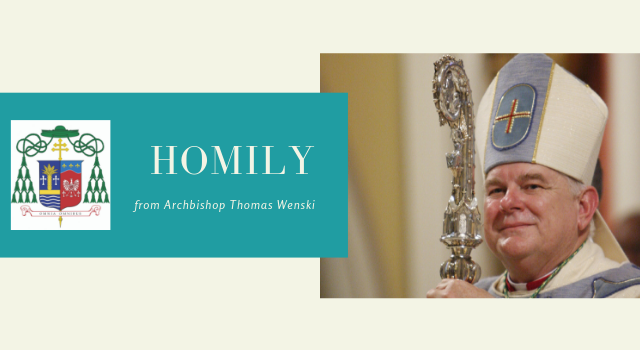By Archbishop Thomas Wenski - The Archdiocese of Miami
Archbishop Thomas Wenski preached this homily during a Mass with the Filipino community for the feast of the Santo Niño, celebrated at St. Bernard Church in Sunrise, Jan. 16, 2022.
Gospel: Luke 2:41-52
Today, the third Sunday of January, the Filipino nation celebrates Sinulog. Viva Santo Niño de Cebu! Pit Señor!
Of course, once again, both here in South Florida as well as the Philippines, COVID has forced us to modify our celebrations. In Cebu City, instead of the traditional foot procession through the streets, there will be a motorcade, a procession of vehicles each one of which with its “Santo Niño.”
In this celebration in which we venerate the image of the Santo Niño “with abundant joy and great rejoicing,” we recall the beginnings of the Catholic faith in the Philippines. We recall, we could say, that beginning of the love story between Christ and the Filipino people.
Through this image of the Christ Child, given to Queen Juana on the day of her baptism, there has emerged a rich Christian culture which has found expression in the art, the music, the literature and above all in the people’s religious traditions and their whole way of being.
Today’s Gospel reading presents us with Jesus being found by his parents teaching in the temple. This is the only place in the gospels that tell us of Jesus’ “hidden life” – his childhood and his years as a young adult. But it shows that Jesus, from the beginning, had a sense of who he was, and what his mission would be.
But the last lines of this Gospel reading are important for us to reflect upon – especially on this feast of the Santo Niño. Luke tells us: “He went down with them and came to Nazareth, and was obedient to them, and his mother held all these things in her heart. And Jesus advanced in wisdom and age and favor before God and man.”
This is of some importance for those of you who live out the Christian vocation to marriage and family. Jesus grew up in a family. He goes home to Nazareth where he lived under the authority of Mary and Joseph. Jesus’ life in Nazareth, a life lived in family – in the Holy Family — and Jesus, Mary, and Joseph’s holy way of life serves as a model for all Christian families. Family life is a path to holiness, the family is the “domestic church,” the basic or first cell of the Church.
When God chose to reveal himself, he did so within a family – and, in a real way, the family is an icon of God, the God who is love. In Nazareth, Jesus lived and learned and loved in a new temple, the temple of the family. Jesus says where two or three are gathered in my name, I am there in their midst. That’s why we can speak of the family as the domestic church, for the first place where two or three are gathered in his name normally should be the family. That’s where children should first learn their prayers, that’s where husbands and wives, sons and daughters, brothers and sisters should both give and experience unconditional love.
The family founded on the marriage of a man and a woman is the path where children best can encounter and know God; where the mutual self-giving and faithfulness of husband and wife provides a secure and protected home for children to best grow in virtue and to assume their own responsibilities as members of society and as citizens of a country. This is what the social sciences indicate – kids with both parents in the home generally do better in school than kids who don’t have both parents.
As we know, not every family can count on both parents in the home for any number of reasons. As you know, life can be messy.
But all parents and all children should strive to imitate the virtues found in that family; but also, the Church invites all families to find in the Holy Family comfort and strength. Mary is a mother for us all – but she can be in a special way a mother to the motherless; and Joseph, the foster father of Jesus, can also be a protector and guide to those who are fatherless or separated from their fathers.
Certainly, the Holy Family knew hardship. They were homeless – for Christ was born in a stable; they were stateless refugees – for Joseph had to flee with Mary and baby into Egypt (and you can be sure that Joseph didn’t wait to cross the border legally). And perhaps in a certain sense, as today’s Gospel suggests, Jesus was for a while an unaccompanied minor.
Like all families, the Holy Family shared both joys and sorrows. Whatever the circumstances of our families, whether headed by a single parent or even in some cases by a grandparent, whether an extended family, nuclear family, blended family, or a broken family, we can make our families temples where God lives with his people.
“All happy families are alike; each unhappy family is unhappy in its own way,” begins Leo Tolstoy's classic work, Anna Karenina. So, no matter how messy life is, we can have not only happy families but holy families if we live out our baptism and our baptismal promises.
This beautiful devotion of the Filipino people reminds us of the humility of Christ, the Santo Niño; and this devotion points out to us the path that we should follow. We dance the sinalog as an expression of our willingness to walk humbly with our Lord.

